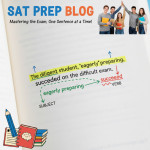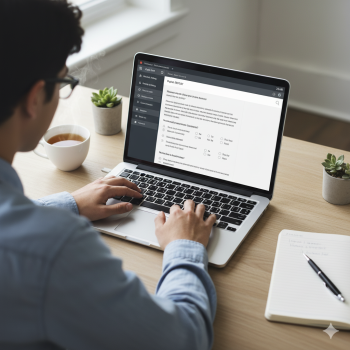Why Healthy Habits Matter More Than All-Nighters
When you strip away the anxiety, the practice tests, and the score-chasing, the truth about great SAT performance comes down to something deceptively simple: consistent, healthy habits. Scores don’t just reflect what’s in a student’s head the night before the test; they reflect weeks and months of sleep cycles, meal patterns, study rhythm, stress management, and the quality of instruction. That means parents and students who focus on building sustainable, human-centered routines—rather than sprinting through last-minute cramming—are much more likely to show up calm, confident, and ready to think clearly on test day.
For students taking the new Digital SAT, a few practical details have changed (device requirements and the Bluebook testing app, for example), but the physiological and psychological needs that underpin solid test performance are timeless. When we talk about modeling healthy habits, we’re not offering platitudes—we’re giving a plan that’s evidence-informed and realistic for busy families.
Important logistical note: the Digital SAT requires a fully charged testing device with the Bluebook app installed and exam setup completed before the test. Treat the tech like part of the test-day checklist, alongside IDs and pencils. ([satsuite.collegeboard.org]( with Sleep: The Non-Negotiable Foundation
Sleep is the single biggest, easiest-to-underestimate factor in cognitive performance. Teens who get consistent, sufficient sleep consolidate learning, improve memory retrieval, and maintain emotional regulation—three things that matter on test day. Aim for consistent bedtimes and wake times during practice months, not just during the week before the test.
Practical Sleep Habits to Model
- Set a consistent wake-up time and bedtime—even on weekends—so circadian rhythm is stable.
- Create a wind-down routine: 30–60 minutes of low-stimulation activities (reading, light stretching, calming music).
- Limit screens that emit blue light at least an hour before bed. If students use devices for study, encourage a switch to paper or night-mode settings early in the evening.
- Practice short daytime naps (20–30 minutes) only if they don’t interfere with nighttime sleep.
Parents modeling these habits—by keeping family quiet during evening hours, avoiding late-night work calls, or setting device curfews—send a powerful, practical message. Teens mimic rhythm more than lecture.
Nutrition and Hydration: Small Changes, Big Returns
What a student eats in the days and weeks before the SAT affects energy, attention, and mood. Think steady blood sugar, steady focus. That doesn’t mean complex meal plans; it means predictable eating patterns and choices that support cognition.
Meal and Snack Strategies
- Breakfast: Include protein and fiber—eggs or Greek yogurt with fruit and whole-grain toast or oatmeal with nuts. Avoid sugary cereals that spike then crash energy.
- Lunch: Combine lean protein, whole grains, and vegetables to maintain steady focus for afternoon study sessions.
- Test Day Snack: Bring a light, familiar snack for the break—banana with nut butter, a small trail mix, or an apple. Avoid new or highly sugary foods that could cause an energy dip.
- Hydration: Keep a water bottle nearby while studying and on test day. Mild dehydration reduces attention and short-term memory.
Modeling this looks like making healthy options available at home, prepping simple grab-and-go snacks together, and normalizing drinking water. On test day, remind students to stick with foods their bodies already tolerate well—now is not the time for culinary experimentation.

Study Rhythm: Quality Beats Quantity
Long, marathon study sessions often yield diminishing returns because attention falters and retention drops. Instead, model and practice focused, repeatable study habits that respect attention spans and reinforce learning.
How to Build a Sustainable Study Schedule
- Short, frequent sessions: Aim for 45–60 minute blocks with 10–15 minute breaks. The brain consolidates better with distributed practice.
- Active over passive: Use mixed practice—timed question sets, error logs, spaced review, and quick content refreshers. Active recall beats passive rereading.
- Weekly structure: Reserve 2–3 blocks per week for full-length, timed practice under realistic conditions to track pacing and endurance.
- End each session with a concrete next step: what to review next, errors to revisit, or a short writing reflection on progress.
When parents show interest—asking about what the student learned, reviewing error logs together, or sitting nearby during silent study—that support helps more than hovering. Modeling study discipline (doing homework, reading, or pursuing quiet work in shared spaces) normalizes the behavior.
Effective Practice: Treat Mistakes as Data
A student’s mistakes are the roadmap to improvement—but only if mistakes are tracked and used. Modeling a growth-oriented response to errors removes shame and creates momentum.
Structured Error-Tracking System
| Element | What to Track | How to Use It |
|---|---|---|
| Error Type | Content (algebra, grammar), question format (multi-step, inference) | Group similar mistakes to target weak spots in mini-lessons |
| Root Cause | Careless, timing, concept gap, misread | Adjust practice focus (timed drills, concept review, reading strategies) |
| Corrective Action | Examples to review, short practice sets | Schedule focused mini-sessions to fix the issue |
| Follow-up | Re-test similar problems after 1 week and 3 weeks | Confirm retention and close the loop |
A practical example: if a student repeatedly misses multistep algebra questions because they rush, the corrective plan might be timed practice with explicit pacing goals and a short checklist to read each step before answering. That combination—diagnose, correct, re-test—drives progress faster than blind repetition.
Stress Management and Mindset: Small Practices with Big Effects
Test anxiety is real, but it’s manageable. Modeling calm reactions to stress and teaching simple techniques gives teens tools they can use during both prep and the test itself.
Daily and Test-Day Practices
- Breathing techniques: Box breathing (4–4–4–4) for two minutes before a practice test or during breaks helps lower nervous arousal.
- Visualization: Spend a few minutes imagining walking confidently into the test center, finding your seat, and calmly reading the first question.
- Micro-breaks: During long practice days, encourage short walks, gentle stretching, or time outdoors to reset focus.
- Reappraisal: Teach students to reframe stress as excitement—an energizing signal rather than a threat.
Parents can model these strategies by narrating their own calming routines—describing how they breathe through a presentation or take a short walk to reset—so kids see coping as a practical skill, not a lecture.
Simulating Test Day: Make the Digital Experience Familiar
The Digital SAT introduces platform-specific elements (Bluebook, built-in Desmos graphing tools, and device rules). Modeling calm around technology and rehearsing the test environment reduces surprises and builds confidence.
Rehearsal Checklist
- Install and practice with Bluebook on the exact device you’ll use for the test and complete exam setup days in advance to generate the admission ticket. ([satsuite.collegeboard.org](
- Practice with the embedded tools: the in-app calculator and navigation features, so students aren’t learning tools on test day.
- Do at least two full-length, timed practice sessions in Bluebook or under realistic digital conditions to simulate pacing and screen reading.
- Pack a ‘test kit’ the night before: fully charged device, charger, printed admission ticket if preferred, acceptable photo ID, and a small snack for the break. ([satsuite.collegeboard.org]( schools may manage devices for SAT School Day, check whether the school will provide and configure the testing device or whether a personal device will be used. If a personal device is used, finish Bluebook setup well before test day. ([satsuite.collegeboard.org]( Idea : A neat flat-lay photo of a student’s ‘SAT test kit’ on a table: laptop/tablet with Bluebook logo visible on screen, charger, photo ID, water bottle, and a banana—visual checklist for test day preparedness.
Pacing, Breaks, and Physical Comfort During the Exam
Building habits around pacing and self-care during practice tests prepares students to use breaks effectively on the real test. The Bluebook app includes timing tools, but students should practice using miniature routines during breaks to keep energy steady.
Test-Day Break Plan
- Use the break to stretch, hydrate, and refocus—avoid high-sugar foods that cause crash later.
- Practice a 60–90 second breathing routine to reset mentally before returning to the test.
- If allowed, use the break to review a tiny checklist of timing goals for the next section (e.g., “keep a steady 1 minute per question on this section”).
Where Personalized Tutoring Fits: Tailoring Habits and Strategy
General habits are essential, but the smartest practice is personalized. When students have targeted weaknesses or inconsistent habits, 1-on-1 guidance can speed up progress by tailoring a study plan and modeling accountability. Personalized tutors can help convert the broad strategies above into a week-by-week plan that fits a teen’s school schedule, extracurriculars, and stress points.
Sparkl’s personalized tutoring offers benefits that fit naturally into a healthy-habit approach: dedicated 1-on-1 guidance to target skill gaps, tailored study plans that respect sleep and school commitments, expert tutors who coach pacing and test-day routines, and AI-driven insights to track mistakes and prioritize practice. When families combine consistent routines at home with expert, individualized coaching, the result is steady, measurable improvement without burnout.
Balancing Life and Test Prep: Realistic Family Practices
Teens have shirts to fold, homework, clubs, and friendships—and a healthy SAT plan should fit, not fight, those responsibilities. Modeling healthy boundaries around time and commitments is vital.
Practical Family Strategies
- Weekly planning huddle: A 10–15 minute family check-in to map out top priorities, including specific study blocks, extracurriculars, and rest periods.
- Block the calendar: Schedule non-negotiable sleep and study windows, then protect them. If a late event is unavoidable, plan a compensatory earlier bedtime.
- Teach decision trade-offs: If a student wants to say yes to an extra rehearsal or trip, use it as an opportunity to practice responsible tradeoffs (what will be rescheduled?).
- Create a visible progress board: Celebrate small wins—completed practice tests, content milestones, and improvements in timing.
Measuring Progress Without Obsession
Scores and practice-test percentiles matter, but obsessing over every point can crush motivation. Model balanced measurement: look for trends, not single-test results.
Metrics That Tell a Useful Story
- Accuracy by question type (e.g., algebra, reading inference) instead of overall raw score on one practice test.
- Timing consistency across sections—are pacing errors reducing?
- Retention checks: can the student correctly do a formerly-missed problem two weeks later?
- Well-being markers: stable sleep schedule, appetite, and mood during heavy practice periods.
When parents respond to a dip by asking clarifying questions (“What went wrong?”) rather than punitively reacting, students learn to treat setbacks as useful data, not as character judgments.
A Sample 8-Week Healthy Prep Plan (Flexible Template)
Week Focus Weekly Commitments 1–2 Baseline & Habits Diagnostic full-length digital practice; set sleep/wake routine; 3 short study blocks + 1 skills block. 3–4 Skills & Pacing 2 targeted content sessions; weekly timed section practice; family check-in; nutrition tweaks. 5–6 Test Simulation & Stress Skills 2 full-length simulated tests (Bluebook if possible); breathing/visualization practice; sleep reinforcement. 7 Polish & Logistics Light targeted drills, device checks, pack test kit, rest emphasis. 8 Rest & Confidence Two light reviews, consistent sleep, clear test-day plan, and a confidence-building family ritual. Real-World Examples: What This Looks Like in a Family
Example 1: Maya, a junior who procrastinates. Her mom modeled small changes: 10-minute nightly reflection instead of late social scrolling, a packed snack in the fridge for morning study, and a short walk before evening homework. Maya’s tutor (working with her once weekly) built short targeted practice sets for her algebra weaknesses and used Sparkl’s AI-driven progress reports to prioritize the week’s work. Within six weeks, Maya’s timing improved and her anxiety decreased because she had a predictable plan to follow.
Example 2: Noah, who reads well but loses focus on long sections. The family instituted a study rhythm: two 60-minute blocks with a 15-minute active break between. His dad began doing a simultaneous quiet work block to model focus. Tutors worked on sustained reading stamina, and test simulations were scheduled for weekends. Noah began approaching passages with strategy instead of dread and reported feeling less drained after practice tests.
Common Pitfalls and How to Avoid Them
- Pitfall: Replacing sleep with ‘one more practice test.’ Fix: Block sleep as a non-negotiable and measure progress by long-term trends.
- Pitfall: Overloading the calendar with endless practice. Fix: Prioritize quality; use error logs to make every practice minute count.
- Pitfall: Treating test prep as a solo burden. Fix: Parents model routines, respect boundaries, and provide logistical support (food, quiet space, transport to practice tests).
Test Day: A Calm, Practical Playbook
On test day, habits are the scaffolding that keeps everything steady. Keep logistics simple, keep the body calm, and follow the practiced routines.
Test-Day Checklist (Night Before & Morning Of)
- Night before: Lay out acceptable photo ID, printed admission ticket (or accessible in Bluebook), charged device, charger, watch without audible alarm, and test-day snack. ([satsuite.collegeboard.org](
- Morning: Consistent breakfast, arrive early, brief breathing routine before entering, and a short mental visualization.
- During breaks: Hydrate, stretch, snack lightly, and practice the 60–90 second reset breathing sequence.
Model calmness as a family ritual: a quick hug, an encouraging note in a lunch, or a steady hand on the shoulder can be more helpful than last-minute advice.
Final Thought: Build Habits That Outlast One Test
Preparing for the Digital SAT is about more than a single score. It’s training a young adult in self-management, resilience, and the habits of disciplined learning—skills that pay dividends through college and beyond. When parents model predictable sleep, nourishment, focused practice, and balanced perspective, they give their teens a toolkit for success that reaches far beyond a single weekend in a testing center.
If a student needs additional personalization—whether to accelerate progress, get targeted help with timing, or create a sustainable study plan—personalized tutoring (including 1-on-1 coaching, tailored study plans, expert tutors, and data-driven insights like those offered by Sparkl) can be a practical way to make healthy habits actionable and measurable.
Keep the rhythm human: prioritize rest, steady nutrition, focused practice, and calmness. Habits built this way lead to not only better scores, but better well-being—and that’s the whole point.
Encouragement for Families
Start small. Pick one habit to model this week—an earlier bedtime, a shared healthy breakfast, or a one-hour uninterrupted study block—and watch how consistency compounds. Students often respond to gentle, practical changes more than to pep talks. The next time you see a practice test score, you’ll realize that the real victory was the daily rhythm that made calm performance possible.
















No Comments
Leave a comment Cancel